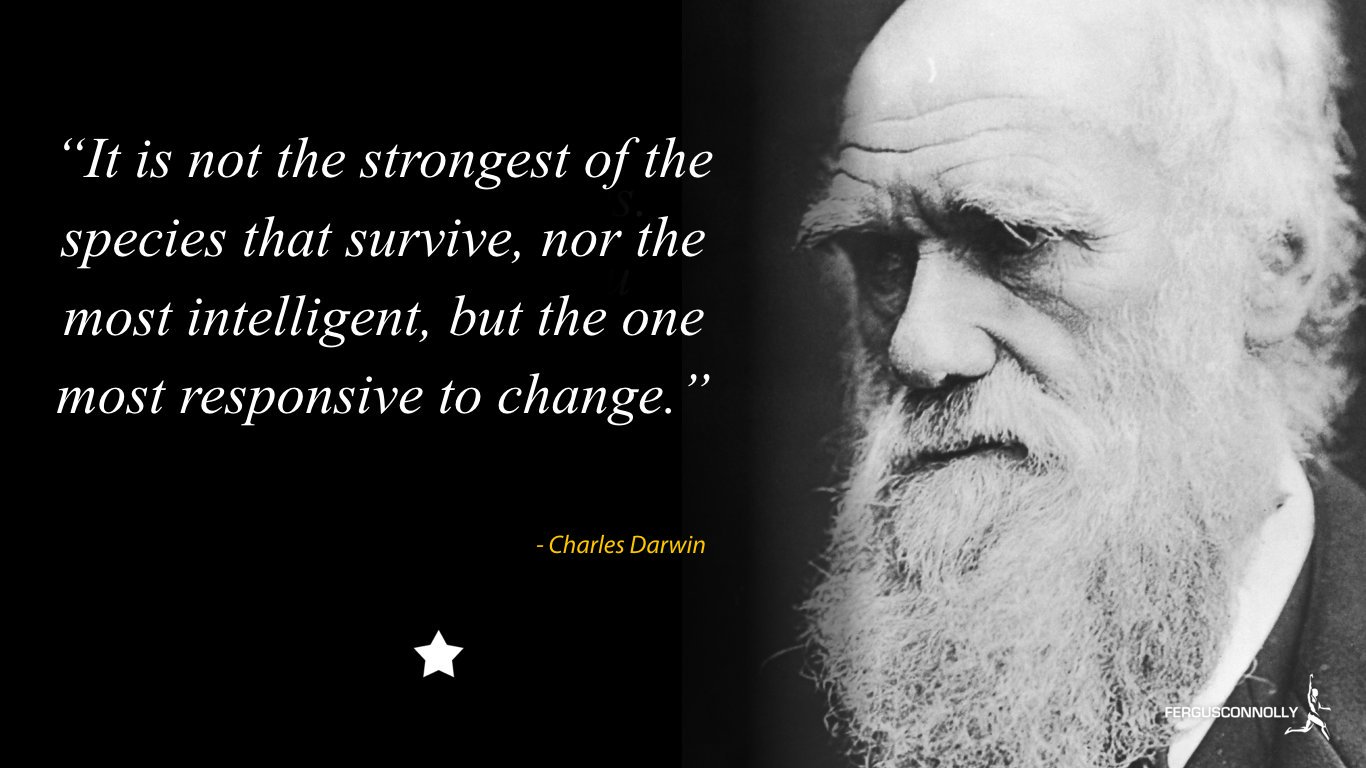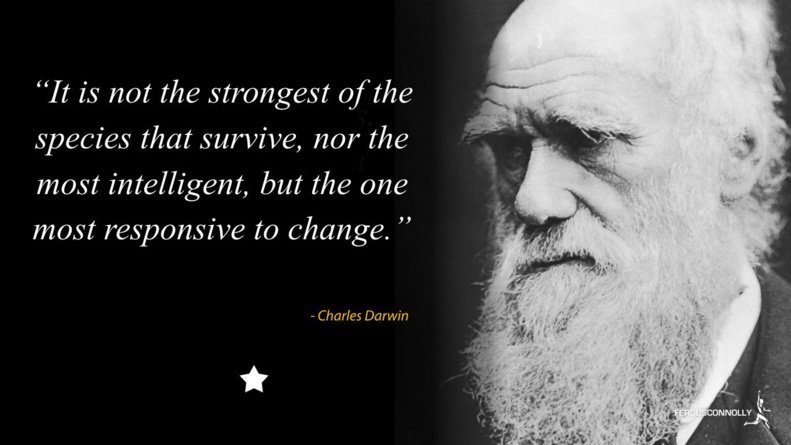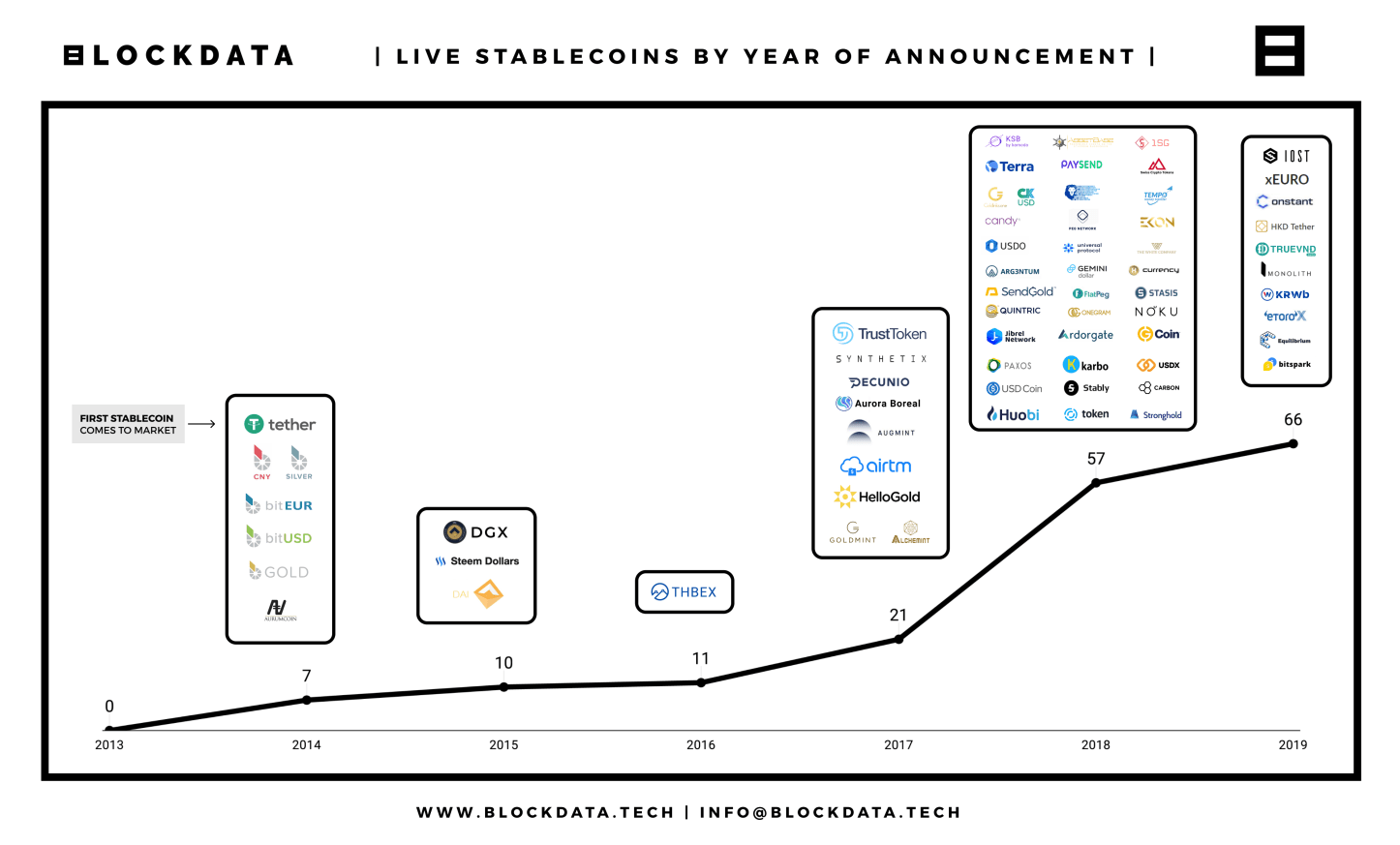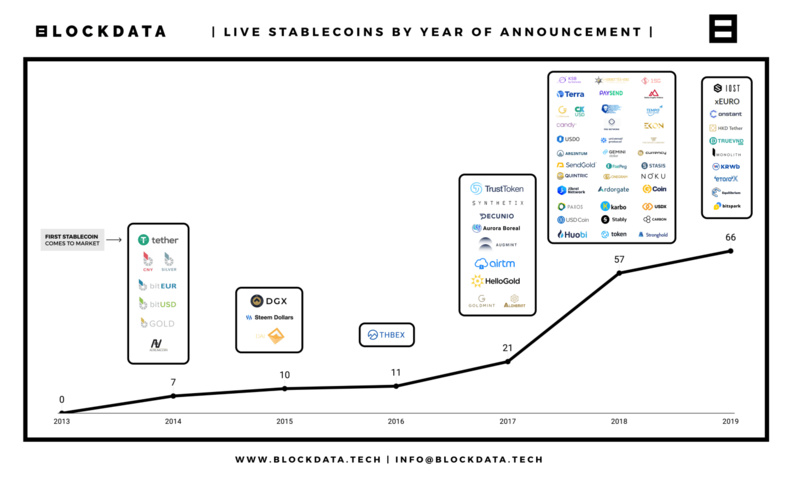Stablecoins are competitors to traditional bank accounts.
New forms of money and their adoption will greatly depend on two things: if they can be used as a store of value and if they can be used as a means of payment. Stablecoins have emerged promising both, making significant strides in the past couple of years. Since 2014, a total of 213 stablecoin projects have been announced. Out of all these projects, 59% are still conducting R&D and not yet trading, 29% are live and 11% are dead due to lack of funding, regulatory issues, or fraudulent behavior. Can stablecoins replace existing financial infrastructure, manage currency risk and reduce back-office fees without causing harm? Are stablecoins like Libra solving a problem or is it just technology for its own sake?
In September, Coinbase celebrated the one year anniversary of the USD Coin (USDC). During this year, USDC established itself as the second most popular stablecoin and the first to reach $1 billion in issuance in less than a year. A few days after its anniversary, in early October, Coinbase announced rewards for customers that held USDC. Customers that hold USDC will earn 1.25% APY. While the interest is not huge, it is comparable to rates many US banks offer for online savings accounts, for keeping in the bank actual fiat dollars.
Stablecoins have a come a long way, with numbers growing rapidly. According to Blockdata, 66 stablecoins are currently live, with more than half announced in 2018.
Stablecoins have developed into a competitor to traditional bank accounts, representing an $18 trillion market opportunity.
New forms of money and their adoption will greatly depend on two things: if they can be used as a store of value and if they can be used as a means of payment. Stablecoins have emerged promising both, making significant strides in the past couple of years. Since 2014, a total of 213 stablecoin projects have been announced. Out of all these projects, 59% are still conducting R&D and not yet trading, 29% are live and 11% are dead due to lack of funding, regulatory issues, or fraudulent behavior. Can stablecoins replace existing financial infrastructure, manage currency risk and reduce back-office fees without causing harm? Are stablecoins like Libra solving a problem or is it just technology for its own sake?
In September, Coinbase celebrated the one year anniversary of the USD Coin (USDC). During this year, USDC established itself as the second most popular stablecoin and the first to reach $1 billion in issuance in less than a year. A few days after its anniversary, in early October, Coinbase announced rewards for customers that held USDC. Customers that hold USDC will earn 1.25% APY. While the interest is not huge, it is comparable to rates many US banks offer for online savings accounts, for keeping in the bank actual fiat dollars.
Stablecoins have a come a long way, with numbers growing rapidly. According to Blockdata, 66 stablecoins are currently live, with more than half announced in 2018.
Stablecoins have developed into a competitor to traditional bank accounts, representing an $18 trillion market opportunity.
Stablecoins are very attractive as a means of payment, because they solve some very basic and important problems, that existing with today’s payment systems: cost, reach, speed and openness. They offer lower costs to send money anywhere in the world, almost instantly and an open architecture that allows us to embed them, into digital applications. They solve all the things, that closed and proprietary legacy banking systems cannot.
Most importantly, stablecoins promise to make transacting, as easy as using social media. Payments are not just about sending money to each other, but about connecting to other people, just like we do on social networks. Stablecoins integrate into our digital lives, in ways that fiat currency cannot.
Major companies are lured by stablecoins and their potential. Wells Fargo and international banks are planning to issue their own stablecoins. Facebook announced Libra. Walmart is prepping for the Walmart Coin. USDC is available in 85 countries. JP Morgan created a digital asset for settling transactions between institutional clients. Binance announced Venus.
It is no coincidence that Facebook launched Libra. When you consider the company reaches more than 2.8 billion people around the world, it was only a matter of time before it came up with a way that would allow them to transact with each other.
For banks like Wells Fargo, stablecoins represent faster, cheaper and more efficient transactions, compared to SWIFT. Using stablecoins a bank can move money around the clock, from only a few hours a day, five days a week.
Walmart filed for a cryptocurrency patent that follows Facebook’s footsteps. The filing revealed that Walmart wants to pursue a stablecoin pegged to a fiat currency. The company’s goal with the cryptocurrency is to provide accessibility to those that do not access banking services.
Binance Venus could be viewed as even more ambitious than Libra, since the project intends to develop localized stablecoins pegged to regional fiat currencies and work with developing countries to help them create new digital currencies.
While stablecoins are under continuous development,, and have established themselves as a possible future of money, risks exist. Policymakers need to create an environment that maximizes benefits and minimizes risks.
Recently, a G7 report outlined nine “significant risks” posed by stablecoins, from the potential for money laundering to tax compliance. In particular, the report said that company-created digital currencies, such as Facebook’s Libra project, “pose challenges for competition and antitrust policies” and should not be launched until all legal and regulatory risks are addressed. It also said that Libra, because of its global reach, could “undermine competition in financial markets”, as well as threaten financial stability and monetary policy.
The IMF has said that “Stablecoins are a threat to banking and cash”.
I think that stablecoins are an opportunity to create better money. We are still in a Darwinian selection process, with many different flavors, testing new things to figure out what works and what doesn’t.
Charles Darwin would have built a killer stablecoin. He knew that it’s not necessarily the strongest or the first to arrive, who are most likely to survive. It’s the most adaptable who win in the end. Stablecoins are turning money into a profit-motivated competition, and the ones to survive will be those that create the most adaptable verson.
In the short term, fiat-collateralized stablecoins will dominate. They are “cousins” of the fiat money use today. But over time, as DEXs and dApps grow, crypto-collateralized stablecoins will displace the fiat-based stablecoins. In the future, we’re going to have digital wallets that can store our US dollars, Walmart dollars, Facebook dollars, Google dollars and others. All of our favorite brands will have their own color of money.
Brands are realizing that less volatile cryptocurrencies could provide a solid foundation for many of crypto’s benefits and applications. It will be exciting to see how stablecoins disrupt nearly every industry in the decade to come, starting with the banking industry.
Most importantly, stablecoins promise to make transacting, as easy as using social media. Payments are not just about sending money to each other, but about connecting to other people, just like we do on social networks. Stablecoins integrate into our digital lives, in ways that fiat currency cannot.
Major companies are lured by stablecoins and their potential. Wells Fargo and international banks are planning to issue their own stablecoins. Facebook announced Libra. Walmart is prepping for the Walmart Coin. USDC is available in 85 countries. JP Morgan created a digital asset for settling transactions between institutional clients. Binance announced Venus.
It is no coincidence that Facebook launched Libra. When you consider the company reaches more than 2.8 billion people around the world, it was only a matter of time before it came up with a way that would allow them to transact with each other.
For banks like Wells Fargo, stablecoins represent faster, cheaper and more efficient transactions, compared to SWIFT. Using stablecoins a bank can move money around the clock, from only a few hours a day, five days a week.
Walmart filed for a cryptocurrency patent that follows Facebook’s footsteps. The filing revealed that Walmart wants to pursue a stablecoin pegged to a fiat currency. The company’s goal with the cryptocurrency is to provide accessibility to those that do not access banking services.
Binance Venus could be viewed as even more ambitious than Libra, since the project intends to develop localized stablecoins pegged to regional fiat currencies and work with developing countries to help them create new digital currencies.
While stablecoins are under continuous development,, and have established themselves as a possible future of money, risks exist. Policymakers need to create an environment that maximizes benefits and minimizes risks.
Recently, a G7 report outlined nine “significant risks” posed by stablecoins, from the potential for money laundering to tax compliance. In particular, the report said that company-created digital currencies, such as Facebook’s Libra project, “pose challenges for competition and antitrust policies” and should not be launched until all legal and regulatory risks are addressed. It also said that Libra, because of its global reach, could “undermine competition in financial markets”, as well as threaten financial stability and monetary policy.
The IMF has said that “Stablecoins are a threat to banking and cash”.
I think that stablecoins are an opportunity to create better money. We are still in a Darwinian selection process, with many different flavors, testing new things to figure out what works and what doesn’t.
Charles Darwin would have built a killer stablecoin. He knew that it’s not necessarily the strongest or the first to arrive, who are most likely to survive. It’s the most adaptable who win in the end. Stablecoins are turning money into a profit-motivated competition, and the ones to survive will be those that create the most adaptable verson.
In the short term, fiat-collateralized stablecoins will dominate. They are “cousins” of the fiat money use today. But over time, as DEXs and dApps grow, crypto-collateralized stablecoins will displace the fiat-based stablecoins. In the future, we’re going to have digital wallets that can store our US dollars, Walmart dollars, Facebook dollars, Google dollars and others. All of our favorite brands will have their own color of money.
Brands are realizing that less volatile cryptocurrencies could provide a solid foundation for many of crypto’s benefits and applications. It will be exciting to see how stablecoins disrupt nearly every industry in the decade to come, starting with the banking industry.

Ilias Louis Hatzis
Ilias Louis Hatzis is the Founder & CEO at Mercato Blockchain Corporation AG.
He writes the Blockchain Weekly Front Page each Monday.I have no positions or commercial relationships with the companies or people mentioned. I am not receiving compensation for this post.
Subscribe by email to join the 25,000 other Fintech leaders who read our research daily to stay ahead of the curve.
I have no positions or commercial relationships with the companies or people mentioned. I am not receiving compensation for this post.
http://dailyfintech.com
He writes the Blockchain Weekly Front Page each Monday.I have no positions or commercial relationships with the companies or people mentioned. I am not receiving compensation for this post.
Subscribe by email to join the 25,000 other Fintech leaders who read our research daily to stay ahead of the curve.
I have no positions or commercial relationships with the companies or people mentioned. I am not receiving compensation for this post.
http://dailyfintech.com
Finyear & Chaineum
Lisez gratuitement le quotidien Finyear & sa newsletter quotidienne.
Recevez chaque matin par mail la newsletter Finyear, une sélection quotidienne des meilleures infos et expertises en finance digitale, corporate finance & crypto finance.
Read for free The daily newspaper Finyear & its daily newsletter.
Receive the Finyear's newsletter every morning by email, a daily snapshot of the best news and expertise in digital finance, corporate finance & crypto finance.
------------------------
Chaineum :
Fondée en 2015, Chaineum est un cabinet de conseil en opérations de haut de bilan offrant une expertise de premier plan en matière d’ICO et STO, avec une vision stratégique orientée tant vers le métier de ses clients que sur la technologie blockchain. A ce titre, Chaineum a participé à la mise en œuvre de bonnes pratiques dans le secteur (ICO Charter, Security Token Network).
La division services blockchain de Chaineum, développe la technologie Chaineum Segment, une blockchain privée orientée objets.
About Chaineum:
Founded in 2015, Chaineum is a leading corporate finance advisory firm with a strong expertise in ICO and STO, and a strategic focus on both its clients' business and blockchain technology. As such, Chaineum paved the way in the implementation of certain best practices in this sector (ICO Charter, Security Token Network).
Chaineum's blockchain services division, is developing Chaineum Segment technology, an object-oriented private blockchain.
-------------------------
Recevez chaque matin par mail la newsletter Finyear, une sélection quotidienne des meilleures infos et expertises en finance digitale, corporate finance & crypto finance.
Read for free The daily newspaper Finyear & its daily newsletter.
Receive the Finyear's newsletter every morning by email, a daily snapshot of the best news and expertise in digital finance, corporate finance & crypto finance.
------------------------
Chaineum :
Fondée en 2015, Chaineum est un cabinet de conseil en opérations de haut de bilan offrant une expertise de premier plan en matière d’ICO et STO, avec une vision stratégique orientée tant vers le métier de ses clients que sur la technologie blockchain. A ce titre, Chaineum a participé à la mise en œuvre de bonnes pratiques dans le secteur (ICO Charter, Security Token Network).
La division services blockchain de Chaineum, développe la technologie Chaineum Segment, une blockchain privée orientée objets.
About Chaineum:
Founded in 2015, Chaineum is a leading corporate finance advisory firm with a strong expertise in ICO and STO, and a strategic focus on both its clients' business and blockchain technology. As such, Chaineum paved the way in the implementation of certain best practices in this sector (ICO Charter, Security Token Network).
Chaineum's blockchain services division, is developing Chaineum Segment technology, an object-oriented private blockchain.
-------------------------
No Offer, Solicitation, Investment Advice, or Recommendations
This website is for informational purposes only and does not constitute an offer to sell, a solicitation to buy, or a recommendation for any security, nor does it constitute an offer to provide investment advisory or other services by FINYEAR.
No reference to any specific security constitutes a recommendation to buy, sell or hold that security or any other security.
Nothing on this website shall be considered a solicitation or offer to buy or sell any security, future, option or other financial instrument or to offer or provide any investment advice or service to any person in any jurisdiction.
Nothing contained on the website constitutes investment advice or offers any opinion with respect to the suitability of any security, and the views expressed on this website should not be taken as advice to buy, sell or hold any security. In preparing the information contained in this website, we have not taken into account the investment needs, objectives and financial circumstances of any particular investor.
This information has no regard to the specific investment objectives, financial situation and particular needs of any specific recipient of this information and investments discussed may not be suitable for all investors.
Any views expressed on this website by us were prepared based upon the information available to us at the time such views were written. Changed or additional information could cause such views to change.
All information is subject to possible correction. Information may quickly become unreliable for various reasons, including changes in market conditions or economic circumstances.
No reference to any specific security constitutes a recommendation to buy, sell or hold that security or any other security.
Nothing on this website shall be considered a solicitation or offer to buy or sell any security, future, option or other financial instrument or to offer or provide any investment advice or service to any person in any jurisdiction.
Nothing contained on the website constitutes investment advice or offers any opinion with respect to the suitability of any security, and the views expressed on this website should not be taken as advice to buy, sell or hold any security. In preparing the information contained in this website, we have not taken into account the investment needs, objectives and financial circumstances of any particular investor.
This information has no regard to the specific investment objectives, financial situation and particular needs of any specific recipient of this information and investments discussed may not be suitable for all investors.
Any views expressed on this website by us were prepared based upon the information available to us at the time such views were written. Changed or additional information could cause such views to change.
All information is subject to possible correction. Information may quickly become unreliable for various reasons, including changes in market conditions or economic circumstances.
Autres articles
-
La startup française, Multis s'abrite désormais au sein de l'entreprise suisse, Safe,
-
Pliant : la fintech allemande élève sa Série A au-delà des 50M€
-
La Paris Blockchain Week. Le bilan de l'événement qui met en lumière les innovations et les progrès réalisés par le Web3
-
Nomination | Plug and Play se dote d'un Directeur Général très corporate
-
Mon Petit Placement se place auprès du grand public



















